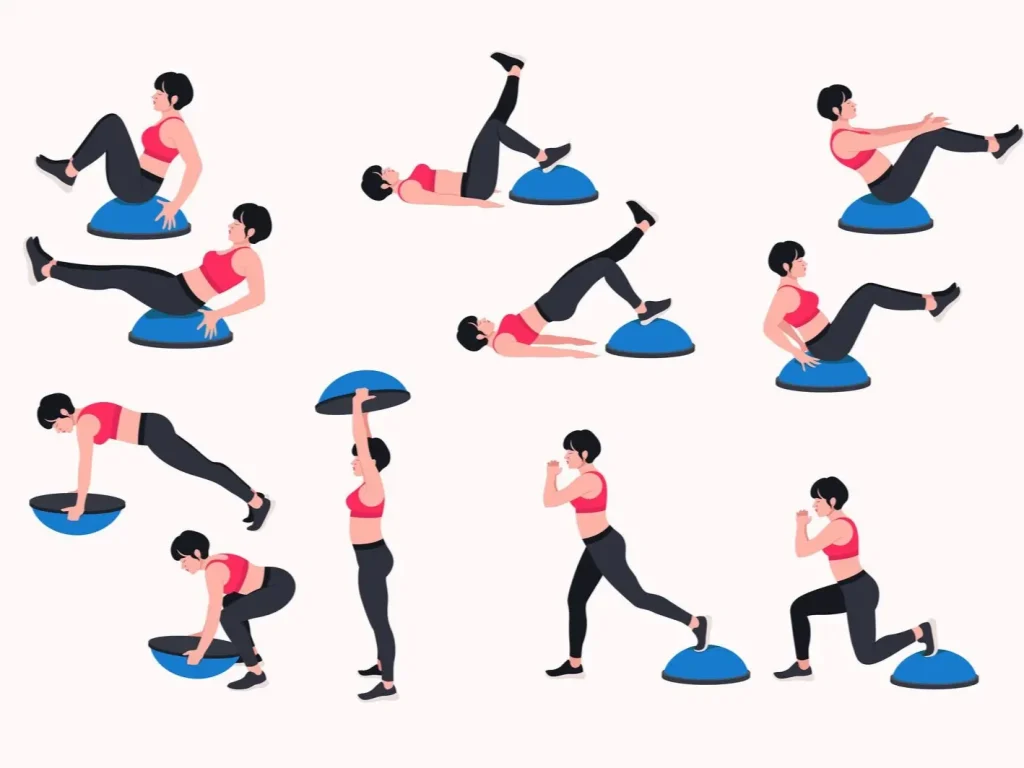If you’re looking for a fun, versatile, and effective way to build strength, improve flexibility, and challenge your core, then an exercise ball workout is the way to go. Whether you’re new to fitness or an experienced athlete, using an exercise ball adds a unique dynamic to your workouts by engaging stabilizer muscles and providing an extra challenge for balance and coordination. In this guide, we’ll cover the benefits of using an exercise ball, along with a variety of exercises that will keep your workouts fresh and exciting.
An exercise ball workout typically involves using a large, inflatable stability ball to perform exercises that target various muscle groups, especially the core. The instability of the ball forces your muscles to work harder to maintain balance, making even simple movements more effective. These workouts are great for improving posture, building core strength, and enhancing flexibility. From beginners to advanced exercisers, anyone can benefit from incorporating an exercise ball into their routine.
What is an Exercise Ball Workout?
An exercise ball workout is a fitness routine that utilizes a stability ball, also known as a Swiss ball or yoga ball. These workouts are designed to engage multiple muscle groups by adding an element of instability, which forces your core and other stabilizing muscles to work harder. This can result in greater muscle activation, improved balance, and increased strength. Whether you’re doing bodyweight exercises or incorporating weights, the exercise ball is a powerful tool to enhance your training.
- Improves Core Stability: Constant engagement of your core muscles.
- Supports Rehabilitation: Useful for injury recovery and physical therapy.
- Versatile Use: Ideal for full-body workouts or targeted exercises.
Benefits of Exercise Ball Workouts
The benefits of an exercise ball workout go beyond just building strength. Here are some key reasons why you should consider adding an exercise ball to your workouts:
- Improves Core Strength: Every exercise on a stability ball requires you to engage your core for balance, which strengthens your abs, lower back, and obliques.
- Enhances Balance and Coordination: The unstable surface of the ball helps improve your body’s ability to balance, leading to better coordination and body control.
- Increases Flexibility: Many stretches and mobility exercises can be performed on an exercise ball, helping you improve your range of motion.
- Versatile and Fun: The ball can be used for a variety of exercises, making your workouts more dynamic and enjoyable.
Top Exercise Ball Workouts for Full-Body Fitness
1. Exercise Ball Squats
Place the exercise ball against a wall and lean your back against it. Perform squats while maintaining balance.
Benefits:
- Strengthens quads and glutes.
- Engages the core for stability.
2. Plank on an Exercise Ball
Rest your forearms on the ball while keeping your body straight in a plank position.
Benefits:
- Builds core strength.
- Improves balance and coordination.
3. Hamstring Curls with a Weighted Exercise Ball
Lie on your back, place your feet on a weighted exercise ball, and curl it toward you.
Benefits:
- Strengthens hamstrings and glutes.
- Enhances lower-body power.
4. Seated Balance Exercise
Sit on the ball with feet flat on the ground. Lift one leg at a time and hold for 10 seconds.
Benefits:
- Improves posture.
- Enhances balance and stability.
5. Russian Twists Using a Weighted Exercise Ball
Hold a weighted ball with both hands while sitting. Twist your torso side to side.
Benefits:
- Targets obliques.
- Builds rotational strength.

10 Best Stability Ball Exercises
Let’s dive into some of the best exercises you can incorporate into your exercise ball workout routine. These exercises target a range of muscle groups, ensuring a full-body workout.
Stability Ball Jackknife
This dynamic core exercise effectively targets the abdominal muscles while engaging the shoulders and hip flexors. It’s a popular choice in gym ball exercises for flat stomach routines due to its core-tightening effect.
- Begin in a push-up position with your shins resting on the exercise ball and hands directly under your shoulders.
- Draw your knees toward your chest, keeping your core tight and back flat. Pause at the peak before extending back to the start.
- This movement not only works the rectus abdominis but also stabilizes the lower back through controlled hip movement.
Tip: For added challenge, incorporate light ankle weights to turn this into an Exercise ball workout with weights variant.
Stability Ball Hamstring Curl
An effective posterior chain exercise, this movement isolates the hamstrings, glutes, and calves, making it ideal for lower-body strength development.
- Lie on your back with heels on the ball, arms by your sides for stability.
- Raise your hips off the ground into a straight line from shoulders to heels, then roll the ball toward your glutes by bending your knees.
- Extend your legs slowly to return. Repeat without letting your hips sag.
This movement is highly beneficial for building strength in the hamstrings and glutes and is often used in Exercise ball workout for beginners programs focusing on injury prevention.
Stability Ball Deadbug
A functional core exercise that improves coordination and core endurance. It’s safe and effective, especially when included in a 10 minute stability ball workout.
- Lie flat on your back with the stability ball held between your hands and knees.
- Lower your right arm and left leg simultaneously while keeping the ball steady. Return to the center and switch sides.
- Focus on keeping your lower back pressed to the floor throughout the movement.
This version intensifies the classic deadbug by demanding additional core engagement to keep the ball stable throughout the motion.
Stability Ball V-Pass
A full-body movement that is excellent for carving out your abs and toning your arms and legs. Ideal for gym ball exercises for flat stomach goals.
- Start lying flat on the floor, holding the ball between your hands above your head.
- Lift your arms and legs simultaneously to pass the ball to your legs, lowering both limbs together without touching the ground.
- Repeat the motion, passing the ball back and forth between hands and feet.
This move not only targets your rectus abdominis but also builds coordination, balance, and flexibility.
Stability Decline Push-Up
Adding the stability ball to decline push-ups increases the difficulty, activating more muscles in the upper body and core.
- Assume a push-up position with your shins or feet elevated on the stability ball.
- Lower your chest toward the ground, keeping your core engaged and elbows at a 45-degree angle.
- Push back up to the start while maintaining stability throughout.
This is a solid Exercise ball workout with weights alternative for intermediate and advanced users when done with a weighted vest.
Stability Ball Wall Squat
One of the most joint-friendly squat variations. This is ideal for those starting with Exercise ball workout for beginners, especially for developing proper squat mechanics.
- Position the stability ball between your lower back and a wall.
- Walk your feet forward slightly and squat down until your thighs are parallel to the ground, keeping the ball in place.
- Press through your heels to return to standing.
This controlled motion reduces strain on the knees and lower back, making it a safe option for all fitness levels.
Russian Twist (with or without Ball)
While commonly done without equipment, adding a stability ball amplifies core and oblique engagement, turning it into a more effective gym ball exercise for flat stomach.
- Sit on the floor with knees bent and heels down.
- Hold the ball in both hands and lean back slightly, keeping your spine neutral.
- Twist your torso to the left and then right, tapping the ball to the floor on each side.
Increase resistance by using a medicine ball for a true Exercise ball workout with weights experience.
Single-Leg Stability Ball Hip Thrust
An advanced glute exercise, this movement isolates each leg and enhances pelvic stability and unilateral strength.
- Rest your upper back on the ball and extend one leg straight out.
- Push through the grounded heel to raise your hips, keeping the extended leg in line with your torso.
- Lower back down with control and switch legs.
It improves hip strength and alignment, making it excellent for runners and athletes.
Stability Ball “I-Y-T” Shoulder Raise
Perfect for improving shoulder stability and posture, this is commonly included in rehabilitation and strength routines.
- Lie face down on the ball, feet grounded wide for support.
- Raise your arms into three positions: straight overhead (“I”), diagonal (“Y”), and horizontal (“T”).
- Hold each position briefly, focusing on scapular control and minimizing momentum.
This movement strengthens the rotator cuff and upper back, especially beneficial for office workers or individuals with shoulder impingement.
Stability Ball Rollout
This is one of the most effective core exercises in any 10 minute stability ball workout for targeting deep abdominal stabilizers.
- Kneel in front of the ball with forearms on top.
- Slowly roll the ball forward, extending your arms while maintaining a flat back and engaged core.
- Pull the ball back to the starting position using your abs, not your arms.
A slow and controlled execution ensures maximum core recruitment and safety for the spine.
How Do You Use an Exercise Ball?
Using an exercise ball is simple, but proper form is crucial to getting the most out of your workout. When performing exercises on a ball, always engage your core and maintain good posture to prevent injury. Start with basic movements like squats and planks, then progress to more advanced exercises as your balance and strength improve.
What Size Stability Ball Should I Get?
The size of your exercise ball matters! Here’s a quick guide based on height:
- Under 5’5″: Choose a 55 cm ball.
- 5’5″ to 6’0″: Opt for a 65 cm ball.
- Over 6’0″: Go for a 75 cm ball.
A ball that’s too small or too large can affect your form and the effectiveness of your exercises, so be sure to select the right size for your height.
Conclusion
An exercise ball workout is a fun and effective way to improve your strength, balance, and flexibility. With so many exercises to choose from, you can easily tailor your workout to your fitness level and goals. Whether you’re using a standard stability ball, a hand exercise ball, or a weighted exercise ball, these versatile tools will keep your workouts fresh and challenging.
If you’re ready to take your fitness to the next level or have any questions, feel free to reach out for personalized advice or workout plans. I’d love to help you get started on your fitness journey!
Read also Chest Muscle Exercises.




